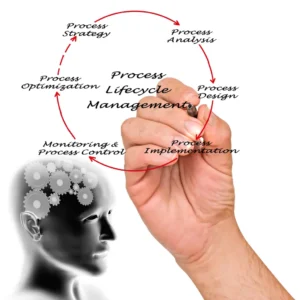
Harmony in Automation
Integrating AI Tools for Intelligent Process Automation (IPA) with Existing Systems
Embarking on the path of Intelligent Process Automation (IPA) entails a strategic juncture where innovation meets the established.
This article talks about how businesses can improve their operations by integrating AI tools with their existing systems for IPA. This approach is transformative and can offer many benefits.
As organizations seek to optimize processes and enhance efficiency, integrating AI tools into pre-existing systems emerges as a linchpin.
The synergy between advanced AI capabilities and the robust foundation of established systems promises automation and a seamless evolution towards unparalleled operational excellence.
This exploration reveals the strategic benefits, challenges, and roadmap for harmonizing AI tools with existing frameworks. The integration journey is not just about technology; it’s a strategic pivot towards resilience, adaptability, and sustained success in the ever-evolving dynamics of modern business.
Understanding Existing Systems
In integrating AI tools with existing systems for Intelligent Process Automation (IPA), a pivotal starting point is a comprehensive assessment of your current infrastructure. This entails a meticulous examination of hardware, software, and data systems.
Assessing Current Systems
Begin by scrutinizing your hardware components, ensuring compatibility with AI tools. Evaluate the efficiency of existing software, identifying areas for improvement. Delve into the intricacies of your data infrastructure, emphasizing the need for seamless data flow.
A robust assessment provides a clear snapshot of the technological landscape, laying the foundation for successful integration. Identify strengths and weaknesses, considering scalability and potential roadblocks.
Identifying Enhanced Processes
Pinpointing the processes and workflows AI tools will augment or automate is integral to the integration strategy. Identify repetitive tasks, bottlenecks, and areas ripe for optimization. This precision ensures that AI aligns with business objectives, enhancing operational efficiency.
Understanding how AI complements existing workflows streamlines the integration process. This knowledge facilitates the selection of AI tools tailored to specific business needs, promoting a seamless fusion of technology and operations.
In conclusion, a thorough understanding of your current systems is the cornerstone for successfully integrating AI tools with existing infrastructure for Intelligent Process Automation. This strategic foundation sets the stage for enhanced efficiency and optimized workflows in the business ecosystem.
Selecting Appropriate AI Tools
Before implementing AI tools into existing systems for Intelligent Process Automation (IPA), it’s essential to establish clear integration goals and objectives. This will ensure a seamless journey towards achieving your desired outcomes. Start by articulating your integration goals and objectives with clarity. Precision in defining these objectives is crucial for a focused and effective implementation.
Articulating Integration Goals
Begin by outlining specific integration goals that align with your business objectives. Clearly define how AI will augment and add tangible value to your existing systems. Identify areas within overall business processes where AI can make a substantial impact.
Adding Value to Existing Systems
Consider how AI can enhance efficiency, reduce operational costs, and optimize resource utilization. Evaluate its potential to streamline workflows, automate repetitive tasks, and provide actionable insights. This clarity ensures that AI integration is purposeful and directly contributes to improving overall business processes.
Strategic Alignment with Business Objectives
Harmonize AI integration goals with broader business objectives. Whether improving customer experience, increasing productivity, or staying competitive, aligning AI objectives with overarching business strategies ensures a cohesive and impactful integration.
In conclusion, a well-defined set of integration goals is the compass that guides the integration journey. By determining how AI will add value to existing systems and improve overall business processes, organizations pave the way for a purpose-driven and successful AI integration for IPA.
APIs and Standardization
The pivotal role of APIs and standardization is critical in the orchestration of Integrating AI Tools with Existing Systems for Intelligent Process Automation (IPA).
Well-documented APIs
Select AI tools that provide well-documented APIs, the conduits facilitating seamless integration. These Application Programming Interfaces serve as bridges, enabling effective communication between diverse systems.
Facilitating Seamless Integration
The clarity and completeness of API documentation are paramount. It ensures that integration processes are swift and error-free, promoting a cohesive technological environment.
Standardizing Data Formats
Harmonize disparate systems by standardizing data formats. This imperative ensures uniformity in information exchange, fostering interoperability among diverse components.
Communication Protocols for Interoperability
Establish standard communication protocols to enhance interoperability. This strategic move eradicates compatibility issues, paving the way for streamlined data flow and collaboration between AI tools and existing systems.
In conclusion, the judicious selection of AI tools must prioritize well-documented APIs and standardization. This approach ensures seamless integration and lays the foundation for harmonizing technologies within the IPA landscape.
Data Migration Planning
A seamless transition into Intelligent Process Automation (IPA) necessitates meticulous Data Migration Planning.
Comprehensive Migration Plan
Craft a comprehensive data migration plan outlining the journey of transferring existing data to the new AI-integrated system. Detail every step to ensure a smooth transition.
Ensuring Smooth Transition
The plan should encompass data mapping, outlining the source and destination, and ensuring a cohesive flow of information. This meticulous approach minimizes disruptions during integration.
Data Validation and Cleansing
Before migration, validate and cleanse data rigorously. Accuracy and completeness are paramount to the success of the integration process.
Data Accuracy for Effectiveness
Ensure that the data is error-free, free of duplicates, and aligned with the required formats. This guarantees the effectiveness of AI tools in processing and utilizing the information.
In conclusion, a well-structured data migration plan, coupled with rigorous validation and cleansing, is the linchpin for successfully integrating AI tools into existing systems for IPA. This strategic approach ensures data integrity and optimizes the functionality of the newly integrated AI landscape.
Data Security and Compliance
In Integrating AI Tools with Existing Systems for Intelligent Process Automation (IPA), prioritizing data security and compliance is paramount.
Robust Security Measures
Implementing robust security measures is imperative to shield sensitive data during integration. This safeguards against potential breaches and unauthorized access.
Fortifying Data Protection
Secure encryption protocols, access controls, and authentication mechanisms fortify the protection of sensitive information. This ensures data confidentiality and maintains the integrity of the integrated system.
Regulatory Compliance
Businesses and organizations must comply with applicable regulations and industry standards for smooth functioning. Whether it’s legal requirements related to data privacy or safety standards that govern the use of specific equipment, it’s essential to stay up-to-date with all relevant guidelines and regulations. Failing to comply with the rules and regulations may result in fines, legal action, and reputational damage. Therefore, it’s critical to establish robust compliance programs and processes regularly reviewed and updated to ensure you’re continuously operating within the bounds of the law and industry best practices. Whether it’s GDPR, HIPAA, or other mandates, compliance ensures ethical and legal use of data.
Ethical Data Practices
Aligning with regulatory frameworks establishes ethical data practices. This not only safeguards against legal repercussions but also fosters trust among stakeholders.
In conclusion, intertwining data security and compliance is foundational in the integration journey. It not only fortifies against potential risks but also upholds ethical standards, ensuring the seamless integration of AI tools into existing systems for IPA.
Testing and Quality Assurance
In the critical phase of Integrating AI Tools with Existing Systems for Intelligent Process Automation (IPA), meticulous testing is the linchpin.
Comprehensive Testing
Conduct extensive testing to unearth and rectify issues within the integration process. Rigorous testing mitigates risks and ensures a robust, error-free integration.
Identifying and Resolving Issues
Thorough testing involves examining AI tools’ compatibility, functionality, and performance. This proactive approach identifies potential bottlenecks and discrepancies, allowing for timely resolution.
Compatibility Testing
Perform dedicated compatibility testing to ascertain the seamless interaction between AI tools and existing systems. This ensures a cohesive technological environment.
Ensuring Seamless Integration
Compatibility testing validates that AI tools harmonize with the diverse components of existing systems. This validation guarantees optimal performance and functionality post-integration.
In conclusion, the significance of testing and quality assurance is high. It is a strategic investment in the success of integrating AI tools into existing systems for IPA, ensuring a smooth and effective transition.
Training and Change Management
In the transformative process of Integrating AI Tools with Existing Systems for Intelligent Process Automation (IPA), focusing on training and change management is pivotal.
Employee Training
Initiate comprehensive training programs to empower employees to utilize the new AI-integrated systems effectively. A well-informed workforce is essential for optimized system utilization.
Empowering Through Knowledge
Training sessions should cover AI tools’ functionalities, benefits, and best practices. This equips employees with the skills needed for seamless integration.
Change Management Strategies
Implementing change management strategies is fundamental to fostering employee adaptation to and embrace of the new technology. Change should be a gradual, well-supported evolution.
Facilitating Smooth Transition
Change management involves transparent communication, addressing concerns, and showcasing the advantages of the new technology. This minimizes resistance and ensures a smoother transition.
In conclusion, the success of integrating AI tools hinges on the preparedness and acceptance of the workforce. By providing thorough training and implementing effective change management, organizations pave the way for harmonious integration into existing systems for IPA.
Documentation
In the meticulous process of Integrating AI Tools with Existing Systems for Intelligent Process Automation (IPA), comprehensive documentation is the linchpin.
Comprehensive System Documentation
Create detailed documentation for the integrated system, encompassing APIs, workflows, and troubleshooting guides. This documentation serves as a guidebook for seamless system understanding and issue resolution.
Navigating Through Integration
Provide clear documentation detailing usage, endpoints, and expected responses for APIs. Workflow documentation should outline processes, ensuring transparency in system operations.
Documenting Best Practices
Record best practices to uphold ongoing support and maintenance standards. This documentation encapsulates the optimal approaches for sustaining system efficiency and longevity.
Sustaining Operational Excellence
Best practices documentation ensures a standardized approach to system usage and upkeep. It becomes a crucial reference for maintaining the health of the integrated system.
In conclusion, meticulous documentation is the backbone of successful AI integration. It facilitates understanding and lays the groundwork for sustained operational excellence in the IPA landscape.
Continuous Monitoring and Optimization
A commitment to continuous monitoring and optimization is paramount in the orchestration of Integrating AI Tools with Existing Systems for Intelligent Process Automation (IPA).
Implementing Monitoring Tools
Deploy advanced monitoring tools to track the performance metrics of the integrated system meticulously. This proactive approach ensures real-time visibility into system operations.
Proactive Performance Tracking
Monitoring tools offer insights into system efficiency, identifying potential bottlenecks or irregularities. This early detection aids in swift issue resolution, maintaining uninterrupted system functionality.
Optimizing AI Models and Configurations
Regularly optimize AI models and system configurations to enhance efficiency and effectiveness. This involves fine-tuning algorithms and adjusting settings to align with evolving business needs.
Fine-tuning for Peak Performance
Continuous optimization ensures that AI models remain aligned with the dynamic nature of business processes. Regular adjustments enhance accuracy, responsiveness, and overall system performance.
In conclusion, implementing continuous monitoring and optimization strategies is pivotal for sustaining the success of AI integration into existing systems for IPA. This iterative approach guarantees immediate issue resolution and fosters perpetual system enhancement.
Table of Contents

Arindam Roy
An Automation Consultant with 25+ years of IT Experience
Related Articles
- Training and Upskilling for AI-Enabled Workforce for IPA
- Challenges in Successful Implementations of AI Tools for IPA
- Addressing Security Concerns in AI-Driven Process Automation
- Integrating AI Tools with Existing Systems for IPA
- Selecting the Right AI Tools for Your Business
- Key Features of AI Tools for IPA: Transforming Processes
- AI Tools for IPA: Revolutionizing Business Efficiency
- Benefits of Implementing AI Tools for IPA
- Understanding the Business Context of IPA
- Evolution of AI in IPA: From Rules to Industry 4.0
Scalability Considerations
Strategic scalability considerations are paramount in Integrating AI Tools with Existing Systems for Intelligent Process Automation (IPA).
Future-Ready AI Tools
Select AI tools and integration strategies with foresight capable of scaling your business’s evolving needs. This forward-thinking approach ensures long-term viability and adaptability.
Adapting to Business Growth
Scalability is not just about the present but also about anticipating future demands. The chosen AI tools should seamlessly grow alongside the business, accommodating increased data volumes and complex workflows.
Strategic Integration Planning
Ensure that integration strategies align with the scalability of AI tools. This involves a holistic approach accommodating expanding datasets, user bases, and intricate business processes.
In conclusion, prioritizing scalability considerations in AI integration lays the foundation for sustained success. A proactive and strategic approach ensures that the integrated system can seamlessly adapt to the evolving needs and growth of the business.
Collaboration with Vendors
In the strategic process of Integrating AI Tools with Existing Systems for Intelligent Process Automation (IPA), fostering collaboration with vendors is instrumental.
Open Communication with Vendors
Establish and maintain open communication channels with AI tool vendors. Stay informed about updates, patches, and new features. Timely information ensures that your integrated system remains technologically current.
Proactive Update Integration
Regular updates and patches address security concerns and introduce enhanced functionalities. Open communication allows for the seamless integration of these updates into your existing system.
Collaborative Problem Resolution
Collaborate closely with vendors to address any compatibility or interoperability challenges that may arise during the integration process. Vendor collaboration ensures swift and effective issue resolution.
Dynamic Problem-Solving Partnership
Vendors possess in-depth knowledge of their tools. Collaborative problem-solving resolves challenges and fosters a partnership focused on improving AI integration.
In conclusion, an active collaboration with AI tool vendors is a linchpin for successful integration. Open communication and collaborative problem-solving create a synergistic relationship, ensuring the longevity and effectiveness of the AI-integrated system for IPA.
Conclusion
In conclusion, the symbiosis of integrating AI tools with existing systems for Intelligent Process Automation (IPA) marks a paradigm shift in organizational efficacy. The seamless synergy between cutting-edge technology and established frameworks offers unparalleled benefits. The advantages are tangible and transformative, from heightened efficiency and streamlined workflows to substantial cost savings. The strategic integration augments operational processes and future-proofs businesses in the rapidly evolving tech landscape.
Moreover, the adaptability and scalability introduced through this integration propel organizations towards sustained growth. The enriched decision-making capabilities, coupled with reduced error rates, not only enhance productivity but also fortify the reliability of business processes. The strategic alignment of AI tools with existing systems ensures a harmonious transition, minimizing disruption while maximizing the innovation potential.
As businesses navigate the complex terrain of digital transformation, integrating AI tools into existing systems is a technological and strategic imperative. It’s a forward-thinking approach that not only elevates operational excellence today but positions organizations for continued success in the dynamic landscape of tomorrow. The journey towards IPA is not merely about automation but crafting a resilient and agile framework that paves the way for sustained success and competitiveness.






















